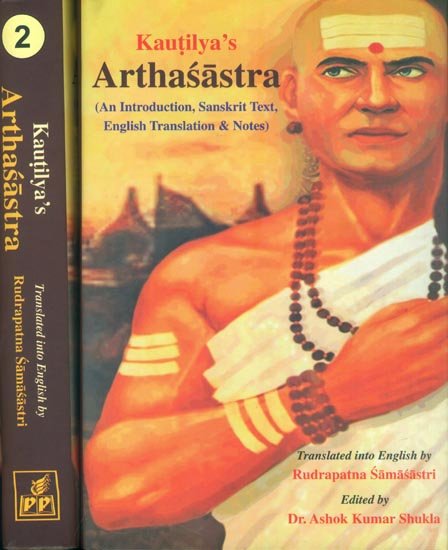Kautilya Arthashastra
by R. Shamasastry | 1956 | 174,809 words | ISBN-13: 9788171106417
The English translation of Arthashastra, which ascribes itself to the famous Brahman Kautilya (also named Vishnugupta and Chanakya) and dates from the period 321-296 B.C. The topics of the text include internal and foreign affairs, civil, military, commercial, fiscal, judicial, tables of weights, measures of length and divisions of time. Original ...
Chapter 3 - Determination of the Place of the Triple Vedas
[Sanskrit text for this chapter is available]
Summary: The End of Sciences (b): Determination of the Place of the Triple Vedas.
The three Vedas,[1] Sāma, Ṛk and Yajus, constitute the triple Vedas. These together with Atharvaveda and the Itihāsaveda[2] are (known as) the Vedas.
Sikṣā (phonetics), Kalpa (ceremonial injunctions), Vyākaraṇa (grammar), Nirukta (glossarial explanation of obscure Vedic terms), Chandas (prosody), and Jyotiṣa (astronomy) form the Aṅgas.
As the triple Vedās definitely determine the respective duties of the four castes and of the four orders of religious life, they are the most useful.
The duty of the Brāhman is study, teaching, performance of sacrifice, officiating in others’ sacrificial performance and the giving and receiving of gifts.
That of a Kṣatriya is study, performance of sacrifice, giving gifts, military occupation, and protection of life.
That of a Vaiśya is study, performance of sacrifice, giving gifts, agriculture, cattle-breeding, and trade.
That of a Śudra is the serving of the twice-born (dvijāti) agriculture, cattle-breeding, and trade (vārtā), the profession of, artizans and court-bards (kārukuśīlavakarma).
The duty of a householder is earning livelihood by his own profession, marriage among his equals of different ancestral Ṛṣis, intercourse with his wedded wife after her monthly ablution, gifts to gods, ancestors, guests, and servants, and the eating of the remainder.
That of a student (Brahmacārin) is learning the Vedas, fire-worship, ablution, living by begging, and devotion to his [8] teacher even at the cost of his own life, or, in the absence of his teacher, to the teacher’s son, or to an elder classsmate.
That of a Vānaprasta (forest-recluse) is observance of chastity, sleeping on the bare ground, keeping twisted locks, wearing deerskin, fire-worship, ablution, worship of gods, ancestors and guests, and living upon foodstuffs procurable in forests.
That of an ascetic retired from the world (Parivrājaka) is complete control of the organs of sense, abstaining from all kinds of work, disowning money, keeping from society, begging in many places, dwelling in forests, and purity both internal and external.
Harmlessness, truthfulness, purity, freedom from spite, abstinence from cruelty, and forgiveness are duties common to ail.
The observance of one’s own duty leads one to Svarga and infinite bliss (Ānantya). When it is violated, the world will come to an end owing to confusion of castes and duties.[3]
Hence[4] the king shall never allow people to swerve from their duties; for whoever upholds his own duty, ever adhering to the customs of the Āryas, and following the rules of caste and divisions of religious life, will surely be happy both here and hereafter. For the world, when maintained in accordance with injunctions of the triple Vedas, will surely progress, but never perish.
[Thus ends Chapter III, “Determination of the Place of the Triple Vedas” among Sciences, in Book I, “Concerning Discipline” of the Arthaśāstra of Kauṭilya.]
Footnotes and references:
[1]:
Observe the order of enumeration.
[2]:
See Chapter V, Book I.
[3]:
Ka. II 9-35.
[4]:
In śloka-metre.
